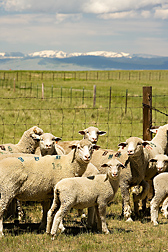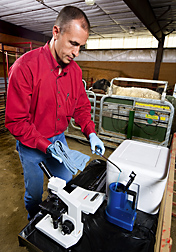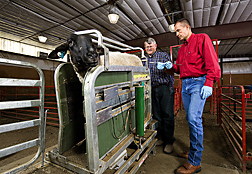New Ultrasound and Artificial Insemination
Techniques Improve Sheep Breeding
Bred for meat as well as wool, sheep have been part of the American landscape since colonial times. Now, advances in genetic research are changing breeding procedures, leading to faster, cheaper, and more accurate techniques.
Using Ultrasound for Selective Breeding
New research is making it easier to predict the future—at least as far as lamb products are concerned. At the U.S. Sheep Experiment Station in Dubois, Idaho, research leader Greg Lewis and his colleagues have shown that ultrasound can be used to accurately predict characteristics that indicate carcass yield and value in live sheep.
This could significantly improve the speed and accuracy of selective-breeding methods. Since carcass data is difficult for producers to obtain, many of them currently rely on visual appraisals to predict carcass traits before choosing which sheep to breed. Ultrasound provides a faster, more accurate alternative.
To assess the reliability of the technology, scientists captured ultrasound images of 172 lambs before slaughter. At Ohio State University, assistant professor Henry Zerby coordinated the collection of carcass-trait data for the lambs. Lewis collaborated with ARS scientists and Dave Notter, a geneticist at Virginia Tech, to analyze the data.
|
|
Results showed that a trained technician can capture an ultrasound image in about 30 seconds with reasonable accuracy. Scientists can use the images to estimate traits that influence the carcass value of market lambs—such as loin muscle area, loin muscle depth, and back-fat thickness.
Ultrasound is initially more expensive than visual appraisals, but the technique’s superior accuracy may translate into better economic returns through improved evaluation and selection of breeding stock.
“Ultrasound is a great way for breeding-stock producers to get the data they need to make selection decisions,” Lewis says.
Reliable predictions are timesavers for breeders because they enable them to make educated decisions about an animal’s offspring without waiting for the offspring to mature. While the technology is used routinely for cattle and swine, this study demonstrates that it can also be applied to sheep.
|
|
Improving Surgical Artificial Insemination
Artificial insemination (AI) is an important tool for modern livestock breeding—particularly for cattle and swine. But for most sheep producers, AI isn’t a viable option. The ovine cervix is relatively difficult to traverse with traditional AI tools, so techniques that work easily with cattle have been less successful with sheep. Surgical AI has a higher success rate, but is prohibitively complicated and expensive.
But help is on the way, thanks to research conducted by ARS animal scientists at the National Center for Genetic Resources Preservation (NCGRP) in Fort Collins, Colorado. Researchers there are collaborating with scientists at the University of Wyoming (UW) to improve semen handling and artificial insemination on sheep farms. The work is being led by NCGRP animal physiologist Phillip Purdy in collaboration with animal geneticist Harvey Blackburn and UW colleagues Robert Stobart and Brent Larson.
“Effective AI has two components: the ability to collect and transport semen—either fresh or frozen—to producers around the country and the ability to economically inseminate the ewes,” Blackburn says.
The scientists first focused on semen collection, storage, and transport. They found that sheep semen can be collected and shipped—in cooled liquid form—overnight before freezing without harming its in vitro quality. They also found that semen could be cryopreserved—or frozen for later use—after shipping without reducing its success in surgical AI.
Further studies compared semen that had been cryopreserved immediately after collection to semen cryopreserved after 48 hours—about the time required to ship samples across the country. The scientists observed no difference in quality or fertilization ability nor in the average number of lambs born to the ewes surgically inseminated with those samples.
“These results show that there are many options available to producers to help them select for desirable traits,” Purdy says. Producers could, for example, use samples from around the world, thereby expanding and improving their breeding options, increasing the quality of their flocks, and providing a better return on their investment.
This work also has benefits for conservators of genetic resources, like the NCGRP, that gather and store genetic materials.
“An efficient insemination method is important for our conservation efforts,” says Blackburn, who heads NCGRP’s National Animal Germplasm Program. “If we can do it more efficiently, we can reduce the number of semen samples we collect for preserving sheep genetic diversity.”
Better Nonsurgical AI
The scientists have developed a rapid, economical alternative to existing surgical AI methods. The technique is an adaptation of the method used in swine. The researchers used a spiral insemination catheter to traverse the ewe’s cervix and deposit thawed semen directly into the uterus. The method is easy to learn and easy to perform. Each sheep takes about 2 minutes to inseminate at a cost of $1.29, making it significantly faster and less expensive than laparoscopic surgical insemination. And it’s easy enough for producers to do independently.
Though quick and economical, the technique is less reliable than existing AI methods. Early tests have had success rates of about 55 percent when using fresh semen and about 10 percent when using frozen semen.
“This difference was not observed in the previous experiments, because surgical inseminations deposit the AI dose at the site of fertilization, so minimal stress is placed on the thawed sperm,” Purdy explains. “Sperm are generally weakened by the freezing and thawing processes, and this impaired function in thawed samples becomes more noticeable when using the nonsurgical method because the sperm have to travel farther to the site of fertilization.”
The scientists are investigating how to hone the technique and improve its success rate by improving the timing of estrus and insemination.—By Laura McGinnis, formerly with ARS.
This research is part of Food Animal Production (#101), an ARS national program described on the World Wide Web at www.nps.ars.usda.gov.
Phillip H. Purdy is with the USDA-ARS National Center for Genetic Resources Preservation, 1111 South Mason St., Fort Collins, CO 80521-4500; phone (970) 495-3258, fax (970) 221-1427.
Gregory S. Lewis is with the USDA-ARS U.S. Sheep Experiment Station, 19 Office Loop, Dubois, ID 83423-5032; phone (208) 374-5306, fax (208) 374-5582.
"New Ultrasound and Artificial Insemination Techniques Improve Sheep Breeding" was published in the October 2009 issue of Agricultural Research magazine.










